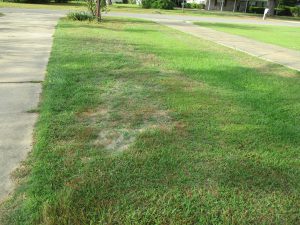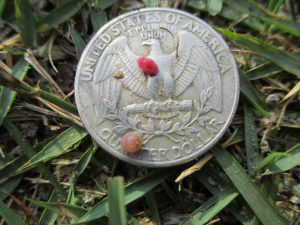There are numerous reasons why maintaining a North Florida lawn is challenging and ultimately frustrating.
One such reason is ground pearls.
Ground pearls, small-scale insects that bother turfgrass roots, are soil dwelling pests that are not much of a problem in northern lawns. But they are quite the problem in North Florida lawns.
Most people, having never heard of ground pearls, may blame weeds, mole crickets and a multitude of other possible causes for their lawn’s demise. But in the last two to three years, this insect seems to have become more of a problem in many of our lawns, including mine.
Unfortunately, there is no effective chemical control for ground pearls in lawns.
Ground pearls feed on roots of bermudagrass, bahiagrass, St. Augustinegrass and zoysiagrass but prefer centipedegrass. They suck juices from the roots. Their feeding eventually causes areas of the lawn to thin and die out to bare ground, especially when the grass is under stress due to drought, nutritional deficiencies, etc.
Many times, the dying areas are somewhat circular or serpentine in pattern. Sometimes the circular areas coalesce, forming larger, irregular shaped dying areas. Weeds tend to invade infested areas.
The quote below, taken from a UF/IFAS Extension publication on this insect, provides some insight into their life cycle. “Clusters of pinkish-white eggs, covered in a white waxy sac, are laid in the soil from March to June. Tiny crawlers attach to roots and cover themselves with a hard, yellowish to purple, globular shell. These “pearls” range in size from a grain of sand to about 1/16 inch. They may occur as deep as 10 inches in the soil. The adult female is 1/16 inch long, pink in color, with well-developed forelegs and claws. Adult males are rare, tiny, gnat-like insects. One generation may last from 1 to 2 years.”
It is the immature stage (nymphs), which look somewhat like tiny pearls from which they get the “ground pearl” name. In this stage, they look like tiny shiny pearls once they are uncovered and exposed to sunlight. They are less than a BB in size. They overwinter in the “pearl” stage.
The ineffectiveness of insecticides is at least partly due to the ground pearl’s ability to avoid insecticides because of being protected in the soil and because of the prolonged protective “pearl” stage of its life cycle.
Since there are currently no biological or chemical controls that work, it’s recommended to minimize lawn stress and maintain proper fertilization and irrigation to help grass tolerate the damage.
Additional information on ground pearls is available at the following UF/IFAS Extension publication “Ground Pearls”.
- Know What You’re Doing when Amending Florida’s Sandy Soil - December 18, 2025
- Evaluate and Renovate Landscape During Fall - October 30, 2025
- Summer is Too Hot for Lawn Herbicides - August 23, 2025


